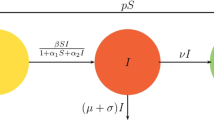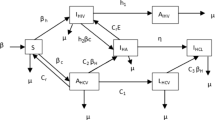Abstract
In this paper, we study the dynamic of a multi-strain SEIR model with both saturated incidence and treatment functions. Two basic reproduction numbers are extracted from the epidemic model, noted \(R_{0,1}\) and \(R_{0,2}\). Using the Lyapunov method, we investigate the global stability of the disease free equilibrium and prove that it is globally asymptotically stable when \(R_{0,1}\) and \(R_{0,2}\) are less than one. Moreover, we formulate the optimal control problem, solve it, and perform some numerical simulations, to support the analytical results and test how well the proposed model may be applied in practice.






Similar content being viewed by others
References
Arino, Julien, Cooke, K.L., Van Den Driessche, P., Velasco-Hernández, J.: An epidemiology model that includes a leaky vaccine with a general waning function. Discrete Contin. Dyn. Syst. Ser. B 4(2), 479–495 (2004)
Bacaër, N.: Daniel bernoulli, d’alembert and the inoculation of smallpox (1760). A Short History of Mathematical Population Dynamics, pp. 21–30. Springer, Berlin (2011)
Bentaleb, D., Amine, S.: Lyapunov function and global stability for a two-strain seir model with bilinear and non-monotone incidence. Int. J. Biomath. (2019)
Bhunu, C.P.: Mathematical analysis of a three-strain tuberculosis transmission model. Appl. Math. Modelling 35(9), 4647–4660 (2011)
Bhunu, C.P., Garira, W.: A two strain tuberculosis transmission model with therapy and quarantine. Math. Modell. Anal. 14(3), 291–312 (2009)
Brenchley, J.M., Price, D.A., Schacker, T.W., Asher, T.E., Silvestri, G., SR, Zachary Kazzaz, E Bornstein, O Lambotte, D Altmann, et al.: Microbial translocation is a cause of systemic immune activation in chronic hiv infection. Nat. Med. 12(12), 1365 (2006)
Buonomo, B., Lacitignola, D.: On the backward bifurcation of a vaccination model with nonlinear incidence. Nonlinear Anal. 16(1), 30–46 (2011)
Capasso, V., Serio, G.: A generalization of the kermack-mckendrick deterministic epidemic model. Mathe. Biosci. 42(1–2), 43–61 (1978)
Danane, J., Allali, K.: Optimal control of an hiv model with ctl cells and latently infected cells. Numer. Algebra Control Opt. 10(2), 207 (2020)
Das, Anjana, Pal, M.: A mathematical study of an imprecise sir epidemic model with treatment control. J. Appl. Math. Comput. 56(1–2), 477–500 (2018)
Feng, Z., Thieme, H.R.: Recurrent outbreaks of childhood diseases revisited: the impact of isolation. Math. Biosci. 128(1–2), 93–130 (1995)
Gao, D-p, Huang, N-j: Optimal control analysis of a tuberculosis model. Appl. Math. Modell. 58, 47–64 (2018)
Golub, J.E., Bur, S., Cronin, W.A., Gange, S., Baruch, N., Comstock, G.W., Chaisson, R.E.: Delayed tuberculosis diagnosis and tuberculosis transmission. Int. J. Tuberculosis Lung Dis. 10(1), 24–30 (2006)
D. J. Gubler. Epidemic dengue and dengue hemorrhagic fever: a global public health problem in the 21st century. In Emerging infections 1, pages 1–14. American Society of Microbiology, 1998
Hethcote, H.W., Thieme, H.R.: Stability of the endemic equilibrium in epidemic models with subpopulations. Math. Biosci. 75(2), 205–277 (1985)
Hethcote, H.W., Van Den Driessche, P.: Some epidemiological models with nonlinear incidence. J. Math. Biol. 29(3), 271–287 (1991)
Zhixing, H., Ma, W., Ruan, S.: Analysis of sir epidemic models with nonlinear incidence rate and treatment. Math. Biosci. 238(1), 12–20 (2012)
Jana, Soovoojeet, Kumar Nandi, Swapan, Kar, T.K.: Complex dynamics of an sir epidemic model with saturated incidence rate and treatment. Acta. Biotheoretica 64(1), 65–84 (2016)
Kar, T.K., Jana, S.: Application of three controls optimally in a vector-borne disease-a mathematical study. Commun. Nonlinear Sci. Numer. Simul. 18(10), 2868–2884 (2013)
Kar, T.K., Jana, Soovoojeet: A theoretical study on mathematical modelling of an infectious disease with application of optimal control. Biosystems 111(1), 37–50 (2013)
William O Kermack and Anderson G McKendrick. A contribution to the mathematical theory of epidemics. In Proceedings of the Royal Society of London A: mathematical, physical and engineering sciences, volume 115, pages 700–721. The Royal Society, 1927
Khan, M.A., Khan, Y., Islam, S.: Complex dynamics of an seir epidemic model with saturated incidence rate and treatment. Phys. A 493, 210–227 (2018)
S. Lenhart, J. T, Workman. Optimal control applied to biological models. Chapman and Hall/CRC, 2007
Liu, W-m, Levin, S.A., Iwasa, Y.: Influence of nonlinear incidence rates upon the behavior of sirs epidemiological models. J. Math. Biol. 23(2), 187–204 (1986)
Lukes, D.L.: Differential Equations: Classical to Controlled. Elsevier, Amsterdam (1982)
Daniel Makinde, O.: Adomian decomposition approach to a sir epidemic model with constant vaccination strategy. Appl. Math. Comput. 184(2), 842–848 (2007)
Okosun, Kazeem O., Ouifki, Rachid, Marcus, Nizar: Optimal control analysis of a malaria disease transmission model that includes treatment and vaccination with waning immunity. Biosystems 106(2–3), 136–145 (2011)
LS Pontryagin, VG Boltyanskii, RV Gamkrelidze, and EF Mishchenko. The mathematical theory of optimal processes, ser. translated from the russian by kn trirogoff; edited by lw neustadt, 1962
Qiu, Z., Feng, Z.: Transmission dynamics of an influenza model with vaccination and antiviral treatment. Bull. Math. Biol. 72(1), 1–33 (2010)
Rachah, Amira, Torres, Delfim F.M.: Mathematical modelling, simulation, and optimal control of the: ebola outbreak in west africa. Discrete Dyn. Nat. Soc. 2015, 2015 (2014)
H. S. Rodrigues, M. T. T. Monteiro, and D. F. M. Torres. Optimal control and numerical software: an overview. arXiv preprint arXiv:1401.7279, 2014
Ruan, S., Wang, W.: Dynamical behavior of an epidemic model with a nonlinear incidence rate. J. Differ. Equ. 188(1), 135–163 (2003)
Sweilam, N.H., AL-Mekhlafi, S.M.: Numerical study for multi-strain tuberculosis (tb) model of variable-order fractional derivatives. J. Adv. Res. 7(2), 271–283 (2016)
Thomasey, D.H., Martcheva, M.: Serotype replacement of vertically transmitted diseases through perfect vaccination. J. Biol. Syst. 16(02), 255–277 (2008)
Van den Driessche, Pauline, Watmough, James: Reproduction numbers and sub-threshold endemic equilibria for compartmental models of disease transmission. Math. Biosci. 180(1–2), 29–48 (2002)
Wang, J.-J., Zhang, J.-Z., Jin, Z.: Analysis of an sir model with bilinear incidence rate. Nonlinear Anal. 11(4), 2390–2402 (2010)
Wang, Wendi: Backward bifurcation of an epidemic model with treatment. Math. Biosci. 201(1–2), 58–71 (2006)
Lih-Ing, W., Feng, Z.: Homoclinic bifurcation in an siqr model for childhood diseases. J. Differ. Equ. 168(1), 150–167 (2000)
Xiao, D., Ruan, S.: Global analysis of an epidemic model with nonmonotone incidence rate. Math. Biosci. 208(2), 419–429 (2007)
Zhang, Xu, Liu, Xianning: Backward bifurcation of an epidemic model with saturated treatment function. J. Math. Anal. Appl. 348(1), 433–443 (2008)
Author information
Authors and Affiliations
Corresponding author
Additional information
Publisher's Note
Springer Nature remains neutral with regard to jurisdictional claims in published maps and institutional affiliations.
Appendix. Numerical Algorithm
Appendix. Numerical Algorithm

Rights and permissions
About this article
Cite this article
Bentaleb, D., Harroudi, S., Amine, S. et al. Analysis and Optimal Control of a Multistrain SEIR Epidemic Model with Saturated Incidence Rate and Treatment. Differ Equ Dyn Syst 31, 907–923 (2023). https://doi.org/10.1007/s12591-020-00544-6
Published:
Issue Date:
DOI: https://doi.org/10.1007/s12591-020-00544-6




